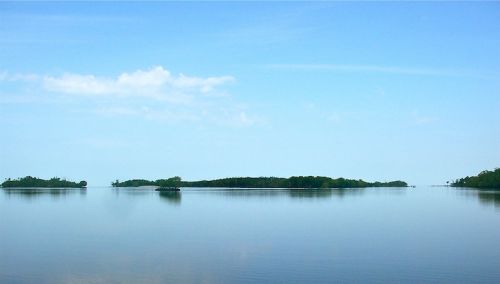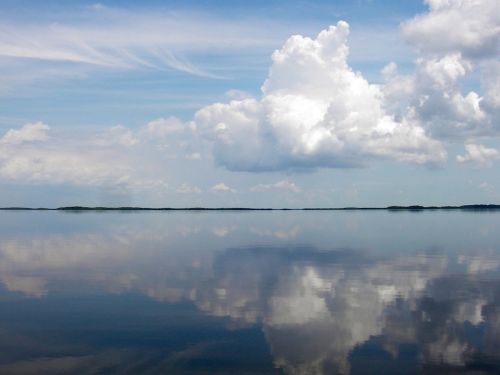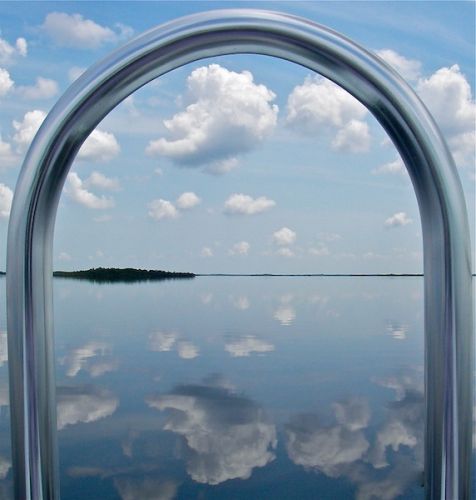Gary Meyer | Tuesday, 4 April 2017
I spent last Saturday with an avid angler addicted to chasing large tarpon on fly. At the end of the day we speculated we had covered 80 miles in his speedy flats boat. Most of our day was spent moving and looking. The remainder was essentially big rod flycasting practice for me. We saw six tarpon roll, or maybe the same tarpon roll six times?
Tarpon fishing back in the mangroves is not like staking out and waiting for the fish to come to you, like on the flats of the Florida Keys. This fishing is in rivers and bays, although some of the bays are very large… like hard to see the other shore large. But no matter, this is an active form of fishing, most of it done while one angler poles the boat and the other stands ready to cast. It is sight fishing in the fact that both anglers are actively watching for tarpon signs, which take many forms. The most common is a roll, where the fish gracefully sips a gulp of air in a continuous motion that exposes the long silver and black back. Other times the fish will show their location by feeding at or just below the surface. This is probably not unlike seeing a trout feed, except that these fish are in the 100 pound range. At other times some tarpon will simply go airborne, called free jumpers. Why they do it is open to discussion, but a six foot gleaming silver fish throwing itself clear of the water is quite a visual clue, even at a rather large distance. The three previous signs are also detectable by ear, two of them easily, but even the roll can be heard. The fourth way to visually detect a tarpon is simply to see it under the water, but in the tannin stained and sometimes wind roiled waters of the outer ‘Glades it is less common, sadly.
There is an art to deciphering these signs. The speed at which the fish is moving, the direction, and how deep they may be holding is all open to interpretation. And guessing all of the above correctly is necessary to present the fly where the fish might find it. Commonly, the take is unseen, a few feet under the surface of the dark water. It is seldom unnoticed however, especially for the angler. I doubt there is a more apt description of this addiction than “the tug is the drug”. And I know most other backcountry tarpon fly anglers will agree. Yes the fight is spectacular, full of jumps and runs, and then a very much a hand to hand combat. It is definitely a team victory, when it happens, because of the required boat handling by the other angler. But, of all that is involved, it is that initial take that makes the pleasure synapsis fire the most.
Our day was not unusual for this time of year. This day was more about searching, and looking, and maybe finding a few fish. It is just a bit early for tarpon to be found in any numbers. We went to none of the spots he usually fishes. This was all about, maybe, finding a new spot or two. There are fish that remain in the area all year, however these local fish are very secretive and scattered. But the thing is this: tarpon have their lies just like trout, and if you find a few when they are scarce, chances are they will gather there too when they are around in numbers. Only die hard addicts like my buddy will even bother with them until the migration starts to unfold. But, said buddy will be out there next week, probably more than once, searching and dreaming about that tug.
Me… I think I’ll be back in my canoe next week. We have a late season front coming that might drop the temperatures one more time. And while this last trip produced no fish, it was a delight to skim across miles of mirror-like waters, which as you might imagine for an area of places with names like “Whitewater Bay” was in itself a treat.
I could not help but make a comparison, in my mind, to the recent canoe trips I’ve made. On them I traveled at but a few miles per hour, and that was when I was truckin’. Additionally, on those trips I never saw another angler, and very few paddlers at all, and I covered less than 10% of the miles. Yet, I was deeper into the wilderness experience, and, at least last time, I caught a shitload of fish!


